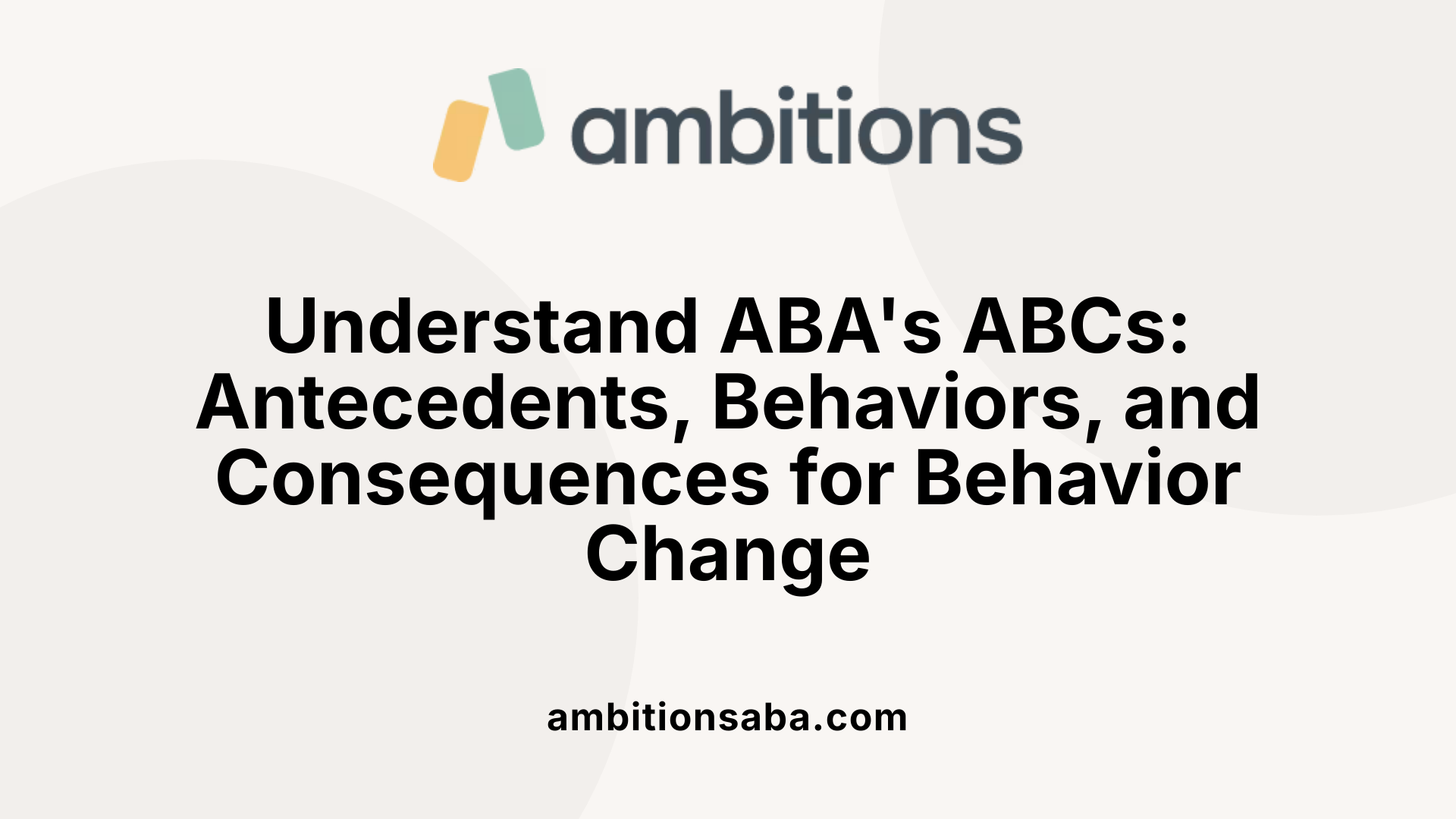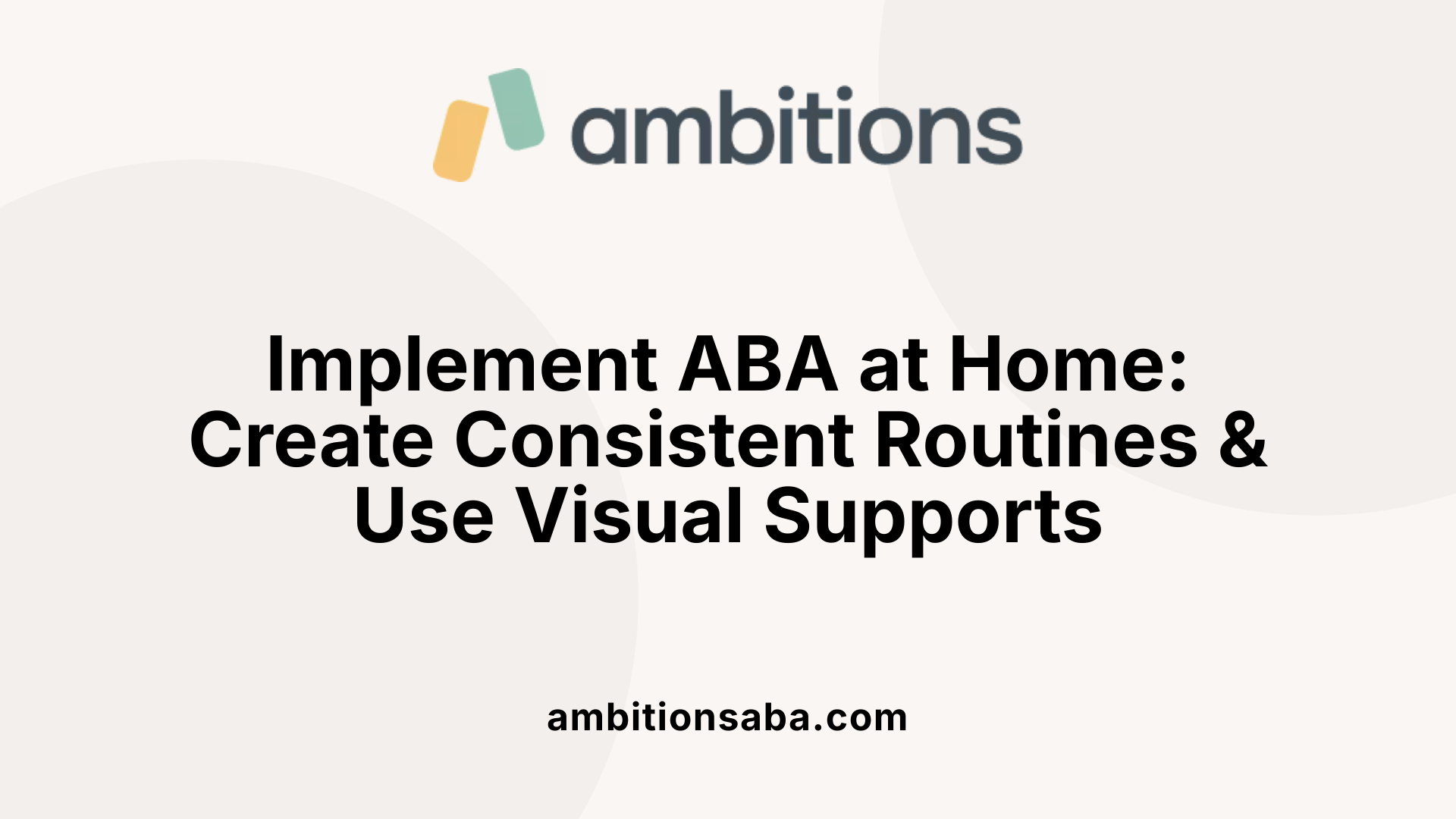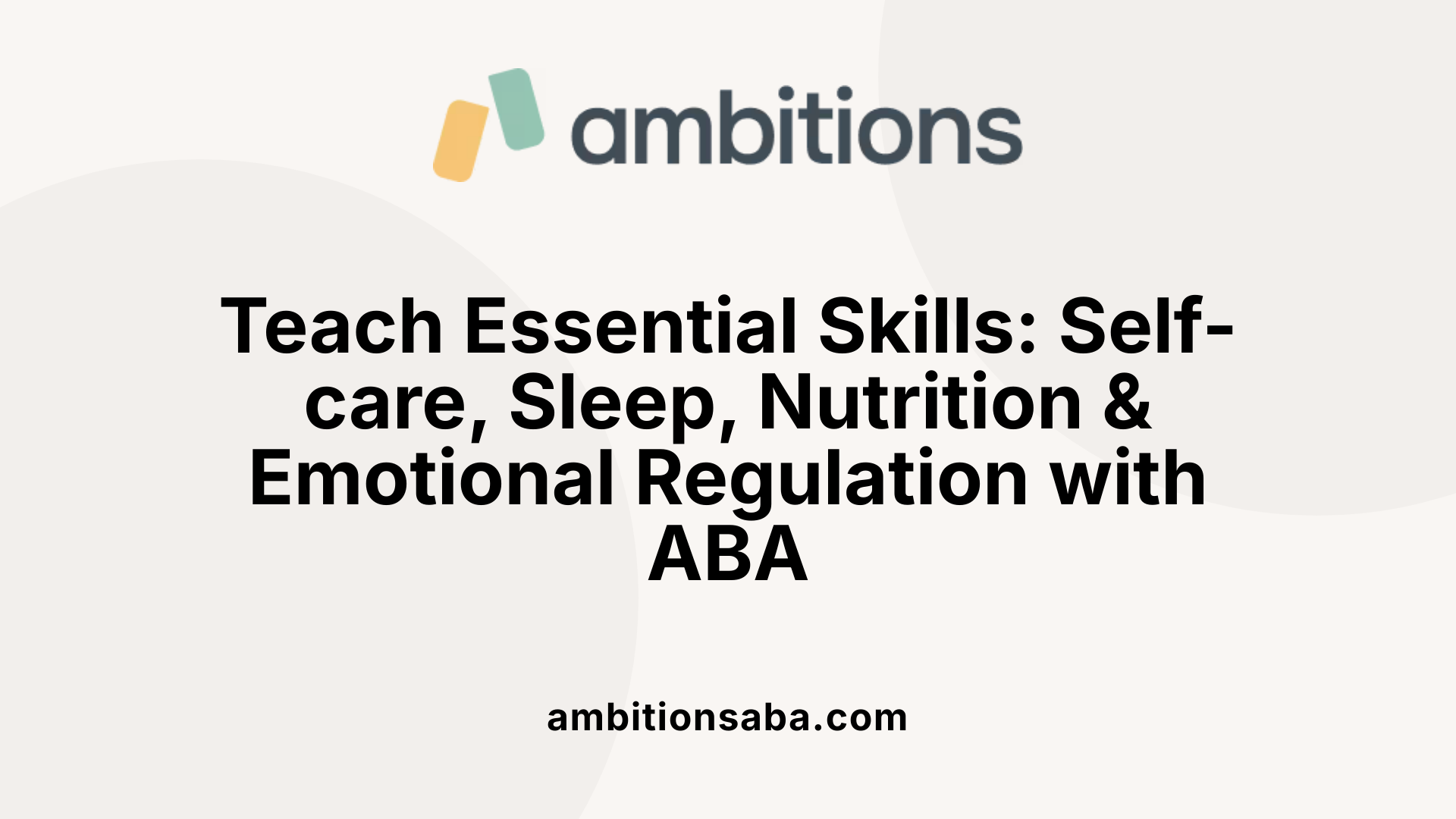Harnessing ABA to Foster Lifelong Healthy Habits
Applied Behavior Analysis (ABA) is a science-backed approach that has proved highly effective in teaching children, especially those with autism, how to develop and maintain healthy habits. By customizing strategies such as positive reinforcement, task analysis, and natural environment teaching, ABA helps integrate essential routines—like self-care, sleep, nutrition, and exercise—into daily life. This article explores how ABA tools can be practically and effectively used at home and in educational settings to promote independence, well-being, and health in individuals across the spectrum.
Core Principles and Techniques of ABA for Healthy Habits

What are the fundamental principles and techniques of ABA for teaching healthy habits?
Applied Behavior Analysis (ABA) is a structured, evidence-based approach rooted in the science of learning and behavior. Its primary focus is to promote positive, functional habits while reducing harmful behaviors. The core of ABA involves analyzing the three components of behavior — antecedents, behaviors, and consequences, often called the ABCs. By understanding what triggers a behavior, the behavior itself, and the outcomes that follow, therapists can design effective interventions.
At the heart of ABA are techniques such as positive reinforcement, shaping, prompting, and altering antecedents to guide behavior change. Positive reinforcement involves rewarding desirable behaviors to increase their occurrence, often using praise, tokens or preferred activities. Shaping is used to teach new skills gradually by reinforcing successive approximations of the target behavior.
Interventions are tailored to each individual and involve careful data collection and analysis. This data-driven approach ensures that strategies are effective and adjusted as needed. Professionals, such as Board Certified Behavior Analysts (BCBAs), design personalized programs that focus on developing healthy routines related to sleep, nutrition, physical activity, and emotional regulation.
Natural Environment Teaching (NET) and errorless learning are also used within ABA to promote skills transfer in everyday settings, like parks or family meals. Techniques such as prompting and fading support independence in tasks like hygiene, cooking, or community navigation.
Overall, ABA’s emphasis on measurable outcomes, social relevance, and flexibility makes it a powerful tool in helping children and adults adopt healthier habits that support overall well-being.
Implementing ABA at Home to Foster Healthy Routines

How can ABA be implemented at home to help promote healthy routines?
Applying ABA principles at home involves creating structured, consistent routines that reinforce healthy behaviors. Caregivers should design daily schedules for essential activities such as sleep, nutrition, and exercise, ensuring these routines are predictable and manageable. Using visual supports like picture charts, visual schedules, timers, and checklists helps children understand what to expect and promotes independence.
Positive reinforcement plays an integral role; immediate praise, tokens, or preferred activities can encourage children to engage in desired behaviors, such as brushing teeth or following a morning routine. Breaking down complex tasks through task analysis and using prompts or cues provides step-by-step guidance, reducing frustration and increasing success.
Incorporating natural learning opportunities within everyday activities enhances skill generalization. For example, involving the child in meal prep, cleaning, or dressing fosters practical skills and reinforces learning in real-world contexts.
Caregiver involvement is vital for ensuring consistency and fidelity in implementing strategies. By actively participating, caregivers can model behaviors, provide immediate feedback, and adjust techniques based on the child's progress.
Visual supports and environmental modifications, such as reducing distractions and organizing materials, support the child's focus and task completion. Data collection and progress monitoring help identify what works best and guide necessary adjustments.
Collaboration with ABA professionals is recommended for tailored planning and ongoing guidance. Additionally, caregiver education ensures strategies are applied effectively to sustain behavior changes.
Overall, a consistent, patient, and individualized approach, enhanced with visual tools and positive reinforcement, promotes healthy routines that become part of everyday life, leading to meaningful improvements in the child's independence and well-being.
Creating Supportive Environments for Teaching Healthy Behaviors

What strategies are recommended for creating a supportive environment conducive to teaching healthy behaviors using ABA?
Designing an effective space for ABA-based teaching requires thoughtful planning of the environment. Using visual supports like picture schedules, visual cues, and checklists helps make expectations clear and predictable, reducing anxiety and encouraging engagement. Setting up routines with consistent schedules and organizing materials in accessible ways fosters a sense of order and safety.
Reducing distractions in the environment helps children focus on learning activities. This can involve decluttering spaces and creating designated areas for different activities, such as quiet zones or play areas. Physical arrangements that promote positive interactions and easy movement support social skills development.
Collaboration between educators, therapists, and family members is crucial. They can develop personalized intervention strategies that are culturally sensitive and aligned with each child's interests and needs. Regular communication ensures consistency across settings.
Another important aspect involves ongoing assessment and adjustments. Regular data collection, environmental assessments, and staff training help identify what works best and refine strategies accordingly. This adaptive approach ensures that the environment continues to support both learning and behavioral progress.
Overall, creating a supportive, well-structured environment utilizing visual tools, routines, and teamwork forms the foundation for successful ABA interventions focused on promoting healthy habits.
Techniques for Teaching Self-care, Sleep, Nutrition, and Emotional Regulation

What methods does ABA use to teach self-care, sleep, nutrition, exercise, and emotional regulation?
ABA employs a combination of proven strategies to help children develop essential health and emotional skills. Central to this approach are tools like task analysis, chaining, and visual supports.
Task analysis involves breaking down complex routines, such as brushing teeth or preparing a healthy snack, into smaller, manageable steps. This helps children understand what to do at each stage, reducing frustration and increasing success.
Chaining uses forward or backward techniques to teach these steps. In forward chaining, instruction begins at the first step, gradually adding steps until the full routine is mastered. Backward chaining starts with the last step, ensuring the child experiences immediate success, which builds confidence.
Visual supports such as schedules, charts, and timers are crucial for establishing routines. They serve as visual cues that guide behavior and reinforce understanding of daily activities like sleep routines, meal times, or exercise schedules.
Positive reinforcement is a core method in ABA. When children perform a desired behavior correctly, they receive praise, tokens, or preferred activities to encourage repetition and mastery.
Modeling provides examples of behaviors for children to imitate. Whether demonstrating proper handwashing techniques or emotional responses, modeling helps children learn through observation.
Natural environment teaching (NET) ensures that skills are practiced in real-life settings, making learning relevant and functional. For instance, practicing social greetings during a family outing or arranging physical activity in the park helps generalize skills.
Social narratives and emotion-focused strategies are used to teach children to identify and regulate their feelings. These tools help children understand emotional cues, cope with anxiety, and develop resilience.
Overall, ABA’s varied methods provide a structured yet flexible framework, helping children gradually incorporate healthy routines into their daily lives.
Educational Resources for Parents and Caregivers
Parents and caregivers seeking to support their children through ABA therapy have access to a broad spectrum of educational materials and tools. Many online resources offer practical, easy-to-use materials such as visual schedules, social stories, picture exchange communication systems (PECS), and reinforcement activity guides. Websites like ABA Educational Resources provide age-specific strategies and evidence-based techniques that help in teaching daily living skills, self-care routines, and health habits.
In addition to digital materials, numerous training workshops and courses are available through certified behavior analysts (BCBAs). These sessions can be attended in person or online, offering tailored guidance for implementing ABA techniques at home effectively. Telehealth services have become especially popular, allowing parents to receive expert support without leaving their homes.
Community organizations and government programs also play vital roles in providing support services, resources, and sometimes funding. Institutions like CHOC or local health departments offer resources and ongoing guidance to help caregivers foster independence and healthy habits in their children. These supports ensure that families are not alone in their journey toward improved developmental outcomes via ABA.
Monitoring Progress and Adjusting Interventions
How can progress in establishing healthy habits with ABA be monitored and assessed?
Tracking progress is a vital part of effective ABA therapy. It involves both systematic data collection and keen observation to see if children are making meaningful improvements.
Parents and therapists gather data through various methods, such as recording the frequency, duration, and quality of target behaviors. This information is then analyzed to identify trends over weeks and months, helping to understand if strategies are successful.
Assessment tools like the Assessment of Functional Living Skills (AFLS) and the Verbal Behavior Milestones Assessment and Placement Program (VB-MAPP) are commonly used to measure progress quantitatively. These tools help gauge skill development in areas like communication, daily living, and social abilities.
Alongside formal assessments, regular review meetings with a qualified behavior analyst, such as a BCBA, are crucial. During these sessions, data is interpreted to determine what is working and what needs adjustment. These reviews guide modifications to therapy plans to better support the child's growth.
Natural and spontaneous observations by parents and caregivers are equally important. Day-to-day environments provide opportunities to see if skills are generalized beyond clinical settings.
If progress seems to stall or regress, collaborative reevaluation of the intervention plan is necessary. Adjustments may include revising goals, changing reinforcement techniques, or incorporating new strategies tailored to the child's evolving needs.
Ultimately, combining quantitative data with qualitative insights ensures a comprehensive view of a child's development, enabling tailored interventions that promote the successful establishment of healthy habits.
Promoting Lifelong Independence and Well-Being
What are the benefits of using ABA to foster independence and health in individuals?
Applied Behavior Analysis (ABA) offers multiple benefits for individuals seeking greater independence and improved health. At its core, ABA teaches essential daily living skills, including personal hygiene, cooking, cleaning, and managing money. These skills are developed through structured task analysis combined with positive reinforcement, which encourages mastery and confidence.
Beyond practical skills, ABA focuses on fostering emotional regulation and self-management abilities. Techniques such as goal setting, stress reduction practices, and emotional awareness help individuals manage their feelings effectively and respond adaptively to various situations.
ABA also plays a vital role in reducing challenging behaviors that could compromise health and safety. By identifying triggers and replacing harmful behaviors with functional alternatives, ABA ensures safer living environments.
Promoting healthy routines is another aspect of ABA’s benefits. Strategies include teaching proper nutrition choices, encouraging physical activity through activities like swimming or yoga, and reinforcing hygiene practices. These routines contribute to overall well-being and resilience.
The approach of ABA is highly individualized, aligning interventions with each person’s unique needs, interests, and goals. This tailored approach results in improved functioning across various domains, ultimately supporting lifelong independence.
In summary, ABA's evidence-based methods empower individuals to lead healthier, more autonomous lives. As a result, they can participate more fully in their communities, pursue employment opportunities, and achieve a higher quality of life.
Empowering Change Through Evidence-Based Strategies
ABA tools provide a comprehensive framework for teaching and reinforcing healthy habits, fostering lifelong independence and well-being. With tailored strategies, consistent implementation, and professional guidance, families and educators can create supportive environments that nurture positive behaviors, promote health, and empower individuals to achieve their fullest potential. The ongoing assessment and adaptation of interventions ensure that these habits are not only learned but maintained over time, ultimately leading to healthier, more autonomous lives.
References
- How ABA Therapy Creates Healthy Habits - Circle Care Services
- Guiding Success: ABA Techniques Tailored for Home Environment
- Ways ABA Enhances Health and Independence for Autistic Adults
- How to Teach Students With Autism Healthy Habits, Life Skills, and ...
- How to Build Healthy Habits for Children with Autism | All Star ABA
- What Are Healthy Habits for Autism? Essential Tips for Well-Being
- Applied Behavior Analysis (ABA) | Autism Speaks
- Enhancing Learning: ABA Therapy Tools Every Parent Needs
- 6 Healthy Habits You Can Build in Your Child with ABA Therapy
- 4 Ways To Monitor Your Child's Progress In ABA Therapy



